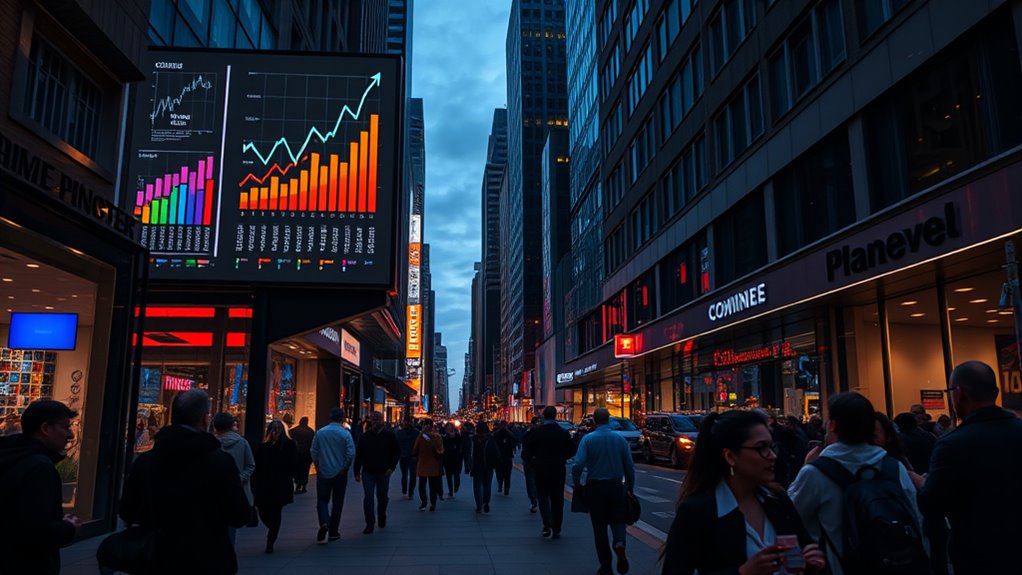Analyzing crime statistics helps you understand how crimes change over time and where they tend to happen. By looking at patterns linked to socioeconomic factors like poverty and unemployment, you can better grasp the root causes. Modern technology, such as surveillance and data analytics, improves detection and response. Combining social data with tech tools lets communities create targeted prevention efforts. Stay tuned to learn how integrating these methods can make your community safer.
Key Takeaways
- Analyzing crime trends helps identify high-risk areas and times, enabling targeted patrols and resource deployment.
- Socioeconomic factors like poverty and unemployment are linked to increased crime rates, guiding prevention efforts.
- Technology such as surveillance and data analytics enhances pattern recognition and suspect identification.
- Combining socioeconomic data with crime statistics provides a holistic approach to addressing root causes.
- Regular trend analysis informs policy development, community engagement, and strategic law enforcement actions.

Crime statistics provide a clear picture of crime trends in your community, helping residents and officials understand where and when crimes are most likely to occur. By analyzing these numbers, you can see patterns that reveal underlying causes and potential risk factors. One key element influencing crime rates is the impact of socioeconomic factors. Areas with higher poverty levels, unemployment, and limited access to education often experience higher crime rates. These conditions can create environments where criminal activity is more likely, whether due to economic desperation or social disenfranchisement. Recognizing these patterns allows community leaders to target resources more effectively, addressing root causes rather than just symptoms. For instance, investing in youth programs or job training can reduce the likelihood of crime in vulnerable neighborhoods.
Understanding community crime patterns helps target resources and address root socioeconomic causes effectively.
At the same time, technological advancements in crime detection have transformed how law enforcement agencies analyze and respond to crime. Modern tools like surveillance cameras, license plate readers, and data analytics platforms enable quicker identification of suspects and patterns. These innovations help law enforcement respond more swiftly, often deterring potential offenders before crimes occur. Additionally, data-driven crime mapping allows officials to deploy resources more strategically, focusing patrols in high-risk areas during peak times. These technological tools not only increase the efficiency of crime prevention but also improve accuracy in investigations, leading to higher clearance rates and safer communities. Moreover, integrating data from various sources enhances predictive capabilities, allowing for more proactive crime prevention.
However, it’s important to understand that technology alone isn’t enough. Socioeconomic factors continue to shape the landscape of crime, and addressing these issues requires a holistic approach. By combining data on socioeconomic conditions with insights gained from technological advancements, communities can develop more effective crime prevention strategies. For example, if crime statistics indicate a spike in burglaries during certain hours in a specific neighborhood, authorities can analyze whether economic hardship or lack of community engagement contributes to this trend. They can then implement targeted outreach, social services, or increased patrols supported by technological tools to mitigate the problem.
In essence, understanding how socioeconomic factors influence crime, alongside leveraging technological advancements, empowers you to be proactive rather than reactive. You can advocate for policies that tackle the root causes of crime while supporting law enforcement’s efforts with cutting-edge tools. This combined approach creates a more detailed picture and ultimately leads to safer, more resilient communities where residents feel secure and supported.
Frequently Asked Questions
How Do Crime Rates Vary by Neighborhood?
You’ll notice crime rates vary markedly between neighborhoods due to disparities in socioeconomic factors, community resources, and local engagement. To address neighborhood disparities, you can support targeted crime prevention strategies like increased patrols, community watch programs, and improved street lighting. By understanding these differences, you can help foster safer environments, encouraging collaboration between residents and law enforcement to reduce crime and promote public safety effectively.
What Factors Influence Fluctuations in Crime Statistics?
You see crime stats shift like a tide, influenced by police resource allocation and community engagement. When authorities focus their efforts and foster trust, crime dips, creating calm waters. Conversely, neglect or lack of connection sparks ripples of unrest. Your neighborhood’s safety hinges on these factors, shaping the ebb and flow of crime. Active policing combined with strong community ties acts as a steady current, steering toward safer streets.
How Accurate Are Crime Data Reporting Methods?
You might find that crime data reporting methods can vary in accuracy because of reporting biases and differences in data collection methods. Some incidents may go unreported or be misclassified, affecting overall accuracy. Law enforcement agencies may also have varying standards for recording crimes, which can skew the data. While these methods aim to provide reliable insights, understanding their limitations helps you interpret crime statistics more critically.
What Are the Most Underreported Crimes?
You might not realize that victim underreporting is common for crimes like domestic violence, sexual assault, and elder abuse. Many victims conceal these crimes due to fear, shame, or mistrust, making them underreported. This concealment skews crime data, hindering public safety efforts. As a result, authorities may not allocate enough resources or develop effective policies to address these hidden issues, leaving victims vulnerable and communities less protected.
How Do Crime Trends Correlate With Socioeconomic Changes?
Think of crime trends as a mirror reflecting socioeconomic impact and demographic shifts. When the economy falters, or populations change, you’ll see crime rates fluctuate—like ripples spreading across water. These shifts can lead to increased poverty, unemployment, or social displacement, which often drive crime. By understanding this connection, you can better anticipate and address public safety concerns, ensuring communities stay resilient despite changing socioeconomic landscapes.
Conclusion
By understanding crime trends, you can better protect yourself and your community. Staying informed helps you spot patterns and take precautions. Remember, “an ounce of prevention is worth a pound of cure.” When you’re proactive, you contribute to safer neighborhoods. Keep analyzing data, stay vigilant, and work together. Safety isn’t just about reacting; it’s about foresight and effort. Stay aware, stay safe—your actions make a difference in shaping a secure environment for all.










